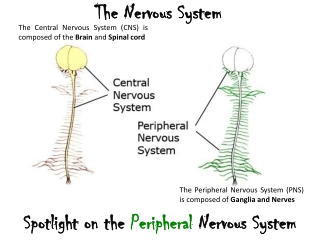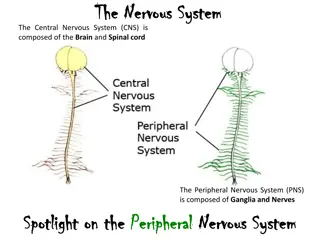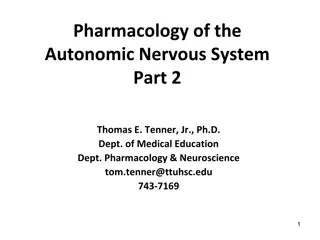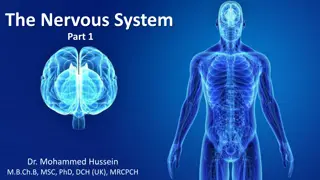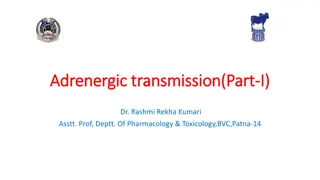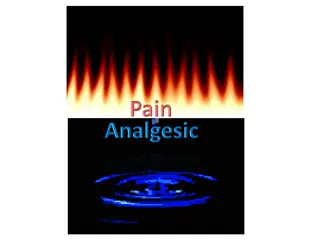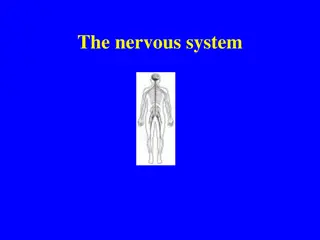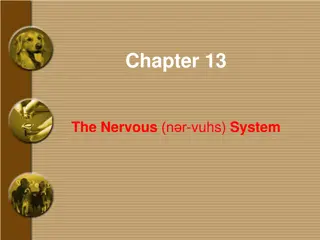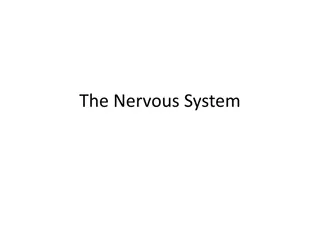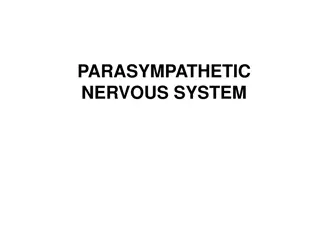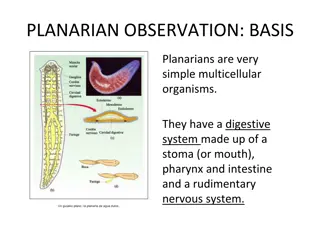Comprehensive Overview of the Nervous System
Explore the anatomy and functions of the nervous system with details on its subdivisions, brain parts, spinal cord features, cranial nerves, and more. Learn about sensory input collection, integration, and motor output functions. Understand the structural and functional organization of the central and peripheral nervous systems. Discover the composition of nervous tissue, the roles of grey and white matter, and definitions of key terms like nucleus, ganglion, tract, and nerve. Dive into the complexities of the brain's regions, including the cerebrum, diencephalon, cerebellum, and brainstem.
Download Presentation

Please find below an Image/Link to download the presentation.
The content on the website is provided AS IS for your information and personal use only. It may not be sold, licensed, or shared on other websites without obtaining consent from the author.If you encounter any issues during the download, it is possible that the publisher has removed the file from their server.
You are allowed to download the files provided on this website for personal or commercial use, subject to the condition that they are used lawfully. All files are the property of their respective owners.
The content on the website is provided AS IS for your information and personal use only. It may not be sold, licensed, or shared on other websites without obtaining consent from the author.
E N D
Presentation Transcript
OBJECTIVES At the end of the lecture, students should be able to: List the subdivisions of the nervous system. Define the terms: grey matter, white matter, nucleus, ganglion, tract and nerve. List the parts of the brain. Identify the external and internal features of spinal cord. Enumerate the cranial nerves Describe the parts and distribution of the spinal nerve. Define the term dermatome List the structures protecting the central nervous system
FUNCTIONS The nervous system has three functions: Collection of Sensory Input: Identifies changes occurring inside and outside the body by using sensory receptors. These changes are called stimuli Integration: Processes, analyses and interprets these changes and makes decisions Motor Output: It then effects a response by activating muscles or glands (effectors) via motor output
ORGANIZATION STRUCTURAL Central Nervous System (CNS) Brain & Spinal Cord Peripheral Nervous System (PNS) Nerves & Ganglia
ORGANIZATION FUNCTIONAL Sensory Division (Afferent) Motor Division (Efferent) Autonomic Somatic
NERVOUS TISSUE Nervous tissue is organized as: Grey matter: which contains the cell bodies & the processes of the neurons, the neuroglia and the blood vessels. White matter: which contains the processes of the neurons (no cell bodies), the neuroglia and the blood vessels.
Nucleus Ganglion A group of neurons within the CNS A group of neurons outside the CNS Nerve Tract A group of nerve fibers (axons) outside the CNS A group of nerve fibers (axons) within the CNS
THE BRAIN Large mass of nervous tissue located in the cranial cavity. Has four major regions. Cerebrum (Cerebral hemispheres) Diencephalon: Thalamus, Hypothalamus, Subthalamus & Epithalamus Cerebellum Brainstem: Midbrain, Pons & Medulla oblongata
CEREBRUM The largest part of the brain, and has two hemispheres. The cerebral hemispheres are connected by a thick bundle of nerve fibers called corpus callosum. The surface shows ridges of tissue, called gyri, separated by grooves called sulci. Divided into 4 lobes by deeper grooves.
Tissue of Cerebral Hemispheres The outermost layer is called gray matter or cortex. Deeper is located the white matter, composed of fiber tracts (bundles of nerve fibers) Carrying impulses to and from the cortex. Located deep within the white matter are masses of grey matter called the basal nuclei . They help the motor cortex in the regulation of voluntary motor activities
CEREBLLUM The cerebellum has 2 hemispheres and a convoluted surface. It has an outer cortex made from gray matter and an inner region of white matter. It provides precise coordination for body movements and helps maintain equilibrium.
QUESTION 4 REVIEW! Whish statement of the following is NOT true? Cerebrum has five major regions. White matter contains the cell bodies & the processes of the neurons, the neuroglia and the blood vessels. The innermost layer of cerebrum is called gray matter or cortex. Cerebellum provides precise coordination for body movements and helps maintain equilibrium.
SPINAL CORD It is a two-way conduction pathway to the brain & a major reflex center 42-45 cm long, cylindrical in shape, lies within the vertebral canal. Extends from foramen magnum to L2 vertebra Continuous above with medulla oblongata Caudal tapering end is called conus medullaris Has 2 enlargements: cervical and lumbosacral Gives rise to 31 pairs of spinal nerves Group of spinal nerves at the end of the spinal cord is called cauda equina
CROSS SECTION OF SPINAL CORD The spinal cord is incompletely divided into two equal parts, anteriorly by a short, shallow median fissure and posteriorly by a deep narrow septum, the posterior median septum. Composed of grey matter in the center surrounded by white matter The arrangement of grey matter resembles the shape of the letter H, having two posterior, two anterior and two lateral horns/columns.
PEREPHERAL NERVES May be sensory, motor or mixed Two types: Cranial: 12 pairs, attached to brain, named, and numbered from1-12 Spinal: 31 pairs, attached to spinal cord named and numbered according to the region of the spinal cord
CRANIAL NERVES 12 pairs 4 pairs are mixed trigeminal nerve. (5th) facial nerve. (7th) glossopharyngeal nerve. (9th) vagus nerve. (10th) 5 pairs are motor occulomotor nerve. (3rd) trochlear nerve. (4th) abducent nerve. (6th) accessory nerve. (11th) hypoglossal nerve. (12th) 3 pairs are sensory olfactory nerve. (1st) optic nerve. (2nd) vestibulocochlear nerve. (8th)
SPINAL NERVES & NERVE PLEXUES 31 pairs Each spinal nerve is attached by two roots: Dorsal (sensory) Ventral (motor) Dorsal root bears a sensory ganglion Each spinal nerve exits from the intervertebral foramen and divides into a dorsal and ventral ramus The rami contain both sensory and motor fibers
SPINAL NERVES & NERVE PLEXUES The dorsal rami are distributed individually. Supply the skin and muscles of the back the ventral rami form plexuses (except in thoracic region where they form the intercostal nerves) Supply the anterior part of the body
DERMATOME Dermatome is a segment of skin supplied by one spinal nerve.
PROTECTION OF CNS THE CNS IS PROTECTED BY: Skull and the vertebral column (bone) Meninges (membranes): 3 layers dura mater (outermost) arachnoid mater (middle pia mater (innermost) Cerebrospinal fluid in the subarachnoid space
CEREBRAL FLUID CSF is constantly produced by the choroid plexuses inside the ventricles of brain. Most of the CSF drains from the ventricles into the subarachoid space around the brain and spinal cord. A little amount flows down in the central canal of the spinal cord. CSF is constantly drained into the dural sinuses through the arachnoid villi.
QUESTION 4 REVIEW! Whish statement of the following is true? Spinal Cord extends from foramen magnum to L2 vertebra Dermatome is a segment of skin supplied by one spinal nerve. CSF is constantly produced by the choroid plexuses outside the ventricles of brain. Spinal Cord is incompletely divided into two equal parts, anteriorly by median fissure and posteriorly by posterior median septum.


